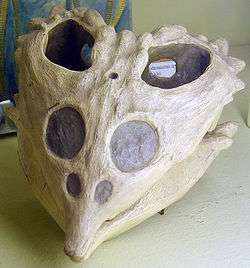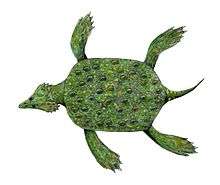Placochelys
| Placochelys Temporal range: Mid to Late Triassic | |
|---|---|
 | |
| Restored Placochelys placodonta skull at the Museum für Naturkunde, Berlin | |
| Scientific classification | |
| Kingdom: | Animalia |
| Phylum: | Chordata |
| Class: | Reptilia |
| Superorder: | †Sauropterygia |
| Order: | †Placodontia |
| Family: | †Placochelyidae |
| Genus: | †Placochelys Jaekel, 1902 |
Placochelys ('flat-plate turtle") is an extinct genus of placodont reptiles erected by Otto Jaekel in 1902.
Fossil records
Fossils of Placochelys dates back to the Triassic period (age range: 221.5 to 205.6 million years ago). They have been found in Germany, Austria, Hungary and Italy. [1]
Species
This genus includes only one species:
- Placochelys placodonta Jaekel, 1902 (from Upper Ladinian of Hungary)
Description
Placochelys looked remarkably similar to a sea turtle, and grew to about 90 centimetres (3.0 ft) in length. It had a flat turtle-like carapace covered with knobbly plates, and a compact triangular skull. Its beaked skull had powerful muscles. It had only two pairs of palatal teeth, a large posterior pair, and a small rostral pair. The specialized broad teeth on the pallet, were most likely used for crushing shellfish and hard-shelled preys. Its limbs were paddle-shaped for swimming, although, unlike modern sea turtles, they still had clear toes, and it also had a short tail.[2]
Gallery
 Life restoration of Placochelys
Life restoration of Placochelys- Placochelys placodonta fossil skull, lateral view
- Placochelys placodonta skull seen from below
Bibliography
- Jaekel O. 1902. Über Placochelys n. g. und ihre Beeutung fur die Stammesgeschichte der Schildkroten: Neues Jahrbuch fur Mineralogie, Geologie und Palaontologie, Abhandlungen, 1902: 127-144.
- Mazin, J.-M. and Pinna, G. 1993. Palaeoecology of the armoured placodonts. Paleontologia Lombarda, N. S. 2: 83-91.
- Rieppel O. and Zanon R.T. 1997. The interrelationships of Placodontia. Historical Biology: Vol. 12, pp. 211-227
- Yin G., in Yin, G., Zhou, X., Cao, Z., Yu, Y, and Luo, Y., 2000, A preliminary study on the Early Late Triassic marine reptiles from Guanling Guizhou, China.
- Rieppel O. 2001. The Cranial Anatomy of Placochelys placodonta Jaekel, 1902, And a Review of the Cyamodontoidea (reptilia, Placodonta) Fieldiana, Geology, New Series, No. 45:1-101.
- Rieppel, O., 2002, The dermal armor of the cyamodontoid placodonts (Reptilia, Sauropterygia): morphology and systematic value: Fieldiana; Geology, new series, n. 46, p. 1-41pp.
References
- ↑ Paleobiology Database
- ↑ Palmer, D., ed. (1999). The Marshall Illustrated Encyclopedia of Dinosaurs and Prehistoric Animals. London: Marshall Editions. p. 71. ISBN 1-84028-152-9.
External links
- The cranial anatomy of Placochelys placodonta Jaekel, 1902, and a review of the Cyamodontoidea (Reptilia, Placodonta) (2001)
- PLACODONTS: THE BIZARRE ‘WALRUS-TURTLES’ OF THE TRIASSIC